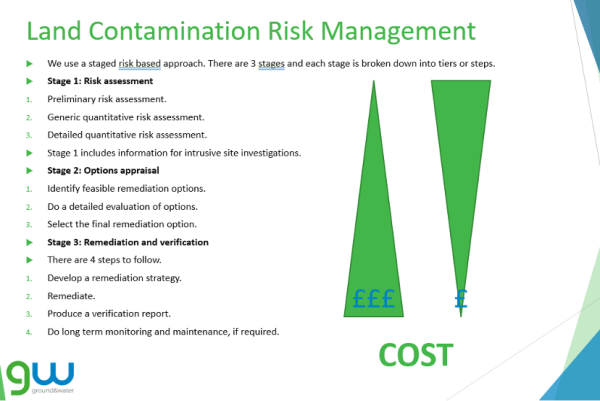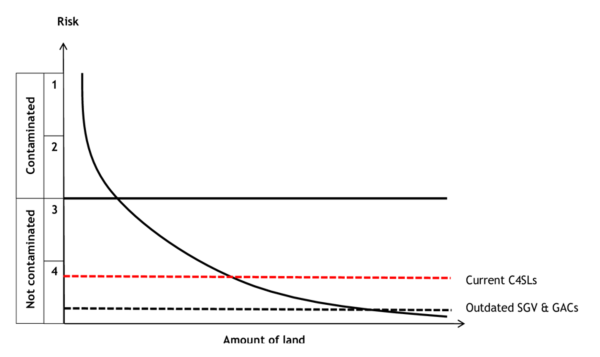G&W Guide to… Tier 2 Contamination Risk Assessments
Geoenvironmental • Regulation
There were justifiable concerns the land earmarked for your next project could be contaminated. You commissioned us to carry out a Phase 1 Contamination Risk Assessment (Desk Study). It has identified one or more potential contaminant linkages that need further assessment. So what happens next?
It’s what we call a GENERIC QUANTITATIVE RISK ASSESSMENT.
 You can see from the slide (opposite) the generic quantitative risk assessment falls into the first stage of the land contamination risk management process. Done thoroughly it can keep the cost of the third stage within managable levels.
You can see from the slide (opposite) the generic quantitative risk assessment falls into the first stage of the land contamination risk management process. Done thoroughly it can keep the cost of the third stage within managable levels.
The generic bit comes from the fact that any soil testing undertaken is compared to a series of guideline values/numbers, which are based on generic assumption on how contaminants will interact with end-users.
Land contamination risk management (LCRM) – GOV.UK gives a great guide to this… We thoroughly recommend you put some time aside to read it.
For a generic quantitative risk assessment, we need to:
- Confirm which linkages need assessing
- Define the objectives for this tier of risk assessment
- Establish if we can use generic assessment criteria and a standard set of generic assumptions to assess the risks
- Do a detailed investigation – this is usually an intrusive Site Investigation
- Decide if generic assessment criteria are suitable to use
- Assess the risks and update the conceptual site model built during Phase 1
- Decide what further action is needed
- Produce a report.
How much Site Investigation data do we need to undertake a generic risk assessment?
This depends on the following factors:
- The complexity of the conceptual site model and the interaction of the site and ground conditions, groundwater, surface water and ground gases and vapours and how climate change could affect these
- The nature of the potential contaminant linkages
- Possible combined or cumulative factors of different contaminants interacting with each other and how climate change could affect this
- Any potential changes in site’s circumstances
- Any uncertainties or limitations in any previous information collected
- The methods of how we will collect and assess the data to achieve the required level of confidence.
As you can see, it’s not the old 1994 DoE CLR4 method of a hotspot radius of 20m.
So you have your SI data which tests the hypothetical ground model… What next? We need to establish what Guideline Values to use.
Identifying appropriate generic assessment criteria
Generic assessment criteria are screening criteria which are derived using a standard set of generic assumptions. They are designed to be broadly applicable to a wide range of site conditions and exposure scenarios. They must be appropriate and suitable for your site.
Generic assessment criteria:
- Relate to the concentration of substances in air, water or soil
- Make generic assumptions about the site characteristics, the contaminant, pathway and receptor behaviour
- Aim to simplify the risk assessment by using a standard approach
- And are used to determine if further risk assessment or more information is required.
We must take into account if they are:
- Too conservative – this may result in an unnecessary more detailed risk assessment or remediation
- Not conservative enough – this would result in the assessment of the risk being incorrect.
They must apply to the:
- Type and form of contaminant we are assessing
- Relevant media – soil, water, sediments, ground gas, vapour and parameters such as soil type, pH, soil organic matter
- Nature and characteristics of the pathway
- Land use – for example, human health criteria are typically more stringent for residential end use than for commercial or public open space
- Type of receptor.
There are loads and loads of generic assessment criteria. They include:
- C4SLs
- Suitable for Use Screening Levels (S4ULs)
- Published soil guideline values (SGVs) (withdrawn).
Examples of ground gases and vapours generic assessment criteria include:
- Society of Brownfield Risk Assessment (SoBRA) Generic Assessment Criteria
- Gas screening values as defined in CIRIA C665: Assessing risks posed by hazardous ground gases to buildings
- Exclusion screening distances for assessing vapour intrusion risk – See: INFO-RA2-4: assessing risks associated with gases and vapours (Lahvis; USEPA) on the CL:AIRE Water and Land Library.
Examples of controlled waters generic assessment criteria include:
- DWSs
- EQSs
For ecology see:
- Soil screening values for assessing ecological risk
- INFO-RA2-5: assessing risks to ecosystems on the CL:AIRE Water and Land Library
Now this next bit is a little technical, but please bear with us.
Section 78A(2): “contaminated land” is any land which appears to the local authority in whose area it is situated to be in such a condition, by reason of substances in, on or under the land that – (a) significant harm is being caused or there is a significant possibility of such harm being caused; or (b) significant pollution of controlled waters is being caused, or there is a significant possibility of such pollution being caused.
Part 2A (Section 78A) above, is more risk section 3 and 2 boundaries… And technically if could be argued that planning departments should adhere to this… BUT!
The key is where to draw, or rather where the regulators draw the line on the graph below. In general terms, generic assessment criteria is conservative, but councils’ planning departments tend to draw their line at the 3 to 4 risk boundaries.

Once we have our SI data, compared to generic assessment criteria, we need to conclude:
- The assessment has shown the risks are low enough that no further action is needed, and you can exit the process
- Further assessment, site investigation and monitoring are required to address uncertainties and complete the risk assessment
- There are unacceptable risks and you need to proceed to detailed quantitative risk assessment or direct to the remediation options appraisal stage.
During all the stages you need to Consider how you will communicate the level of risk to regulators, stakeholders and other interested parties (potentially including the public).
The Ground & Water difference
As you can see, the Generic Quantitative Risk Assessment, is a relatively complex process, but it is a necessary one to undertake, if contaminant linkages are present on your site.
Done thoroughly it has been our experience, in several instances, that following others initially suggesting clients were facing a massive bill for remediation or gas protection measures, it turned out we could demonstrate to the regulator a lower level of risk or a localised risk in one small area on their site. This has saved clients £10,000s and also meant they could get out the ground on budget and on time. You can read examples of this on our case study page.
